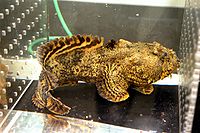
Tetraodontidae is a family of primarily marine and estuarine fish of the order Tetraodontiformes. The family includes many familiar species variously called pufferfish, puffers, balloonfish, blowfish, blowers, blowies, bubblefish, globefish, swellfish, toadfish, toadies, toadle, honey toads, sugar toads, and sea squab. They are morphologically similar to the closely related porcupinefish, which have large external spines.

Frigatebirds are a family of seabirds called Fregatidae which are found across all tropical and subtropical oceans. The five extant species are classified in a single genus, Fregata. All have predominantly black plumage, long, deeply forked tails and long hooked bills. Females have white underbellies and males have a distinctive red gular pouch, which they inflate during the breeding season to attract females. Their wings are long and pointed and can span up to 2.3 metres (7.5 ft), the largest wing area to body weight ratio of any bird.

The swim bladder, gas bladder, fish maw, or air bladder is an internal gas-filled organ that contributes to the ability of many bony fish to control their buoyancy, and thus to stay at their current water depth without having to expend energy in swimming. Also, the dorsal position of the swim bladder means that the expansion of the bladder moves the center of mass downwards, allowing it to act as a stabilizing agent in some species. Additionally, the swim bladder functions as a resonating chamber, to produce or receive sound.

The European shag or common shag is a species of cormorant. It is the only member of the monotypic genus Gulosus. It breeds around the rocky coasts of western and southern Europe, southwest Asia and north Africa, mainly wintering in its breeding range except for the northernmost birds. In Britain this seabird is usually referred to as simply the shag. The scientific genus name derives from the Latin for glutton. The species name aristotelis commemorates the Greek philosopher Aristotle.

Teleostei, members of which are known as teleosts, is, by far, the largest infraclass in the class Actinopterygii, the ray-finned fishes, and contains 96% of all extant species of fish. Teleosts are arranged into about 40 orders and 448 families. Over 26,000 species have been described. Teleosts range from giant oarfish measuring 7.6 m (25 ft) or more, and ocean sunfish weighing over 2 t, to the minute male anglerfish Photocorynus spiniceps, just 6.2 mm (0.24 in) long. Including not only torpedo-shaped fish built for speed, teleosts can be flattened vertically or horizontally, be elongated cylinders or take specialised shapes as in anglerfish and seahorses.

Kleptoparasitism is a form of feeding in which one animal deliberately takes food from another. The strategy is evolutionarily stable when stealing is less costly than direct feeding, such as when food is scarce or when victims are abundant. Many kleptoparasites are arthropods, especially bees and wasps, but including some true flies, dung beetles, bugs, and spiders. Cuckoo bees are specialized kleptoparasites which lay their eggs either on the pollen masses made by other bees, or on the insect hosts of parasitoid wasps. They are an instance of Emery's rule, which states that insect social parasites tend to be closely related to their hosts. The behavior occurs, too, in vertebrates including birds such as skuas, which persistently chase other seabirds until they disgorge their food, and carnivorous mammals such as spotted hyenas and lions. Other species opportunistically indulge in kleptoparasitism.

Filter feeders are a sub-group of suspension feeding animals that feed by straining suspended matter and food particles from water, typically by passing the water over a specialized filtering structure. Filter feeders can be sessile, planktonic or nektonic, and some extant animals that rely on this method of feeding are clams, krill, sponges, baleen whales and many fish. Some birds, such as flamingos and certain species of duck, are also filter feeders. Filter feeders can play an important role in cleaning water, and are therefore considered ecosystem engineers. They are also important in bioaccumulation and, as a result, as indicator organisms.

Animal communication is the transfer of information from one or a group of animals to one or more other animals that affects the current or future behavior of the receivers. Information may be sent intentionally, as in a courtship display, or unintentionally, as in the transfer of scent from predator to prey with kairomones. Information may be transferred to an "audience" of several receivers. Animal communication is a rapidly growing area of study in disciplines including animal behavior, sociology, neurology and animal cognition. Many aspects of animal behavior, such as symbolic name use, emotional expression, learning and sexual behavior, are being understood in new ways.
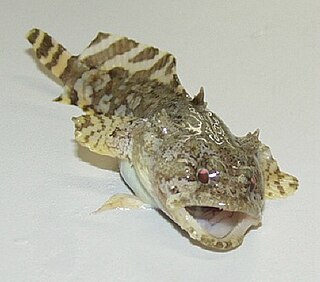
Batrachoididae is the only family in the ray-finned fish order Batrachoidiformes. Members of this family are usually called toadfish or frogfish: both the English common name and scientific name refer to their toad-like appearance.

An egg is an organic vessel grown by an animal to carry a possibly fertilized egg cell and to incubate from it an embryo within the egg until the embryo has become an animal fetus that can survive on its own, at which point the animal hatches.

The little cormorant is a member of the cormorant family of seabirds. Slightly smaller than the Indian cormorant it lacks a peaked head and has a shorter beak. It is widely distributed across the Indian Subcontinent and extends east to Java, where it is sometimes called the Javanese cormorant. It forages singly or sometimes in loose groups in lowland freshwater bodies, including small ponds, large lakes, streams and sometimes coastal estuaries. Like other cormorants, it is often found perched on a waterside rock with its wings spread out after coming out of the water. The entire body is black in the breeding season but the plumage is brownish, and the throat has a small whitish patch in the non-breeding season. These birds breed gregariously in trees, often joining other waterbirds at heronries.

The black caiman is a crocodilian reptile endemic to South America. With a maximum length of around 5 to 6 m and a mass of over 450 kg (1,000 lb), it is the largest living species of the family Alligatoridae, and the third-largest crocodilian in the Neotropical realm. True to its common and scientific names, the black caiman has a dark greenish-black coloration as an adult. In some individuals, the pigmentation can appear almost jet-black. It has grey to brown banding on the lower jaw; juveniles have a more vibrant coloration compared to adults, with prominent white-pale yellow banding on the flanks that remains present well into adulthood. The banding on young animals helps with camouflage by breaking up their body outline, on land or in water, in an effort to avoid predation. The morphology is quite different from other caimans but the bony ridge that occurs in other caimans is present. The head is large and heavy, an advantage in catching larger prey. Like all crocodilians, caimans are long, squat creatures, with big jaws, long tails and short legs. They have thick, scaled skin, and their eyes and noses are located on the tops of their heads. This enables them to see and breathe while the rest of their bodies are underwater.

Pelagic fish live in the pelagic zone of ocean or lake waters—being neither close to the bottom nor near the shore—in contrast with demersal fish that live on or near the bottom, and reef fish that are associated with coral reefs.

A fish is an aquatic, anamniotic, gill-bearing vertebrate animal with swimming fins and a hard skull, but lacking limbs with digits. Fish can be grouped into the more basal jawless fish and the more common jawed fish, the latter including all living cartilaginous and bony fish, as well as the extinct placoderms and acanthodians. Most fish are cold-blooded, their body temperature varying with the surrounding water, though some large active swimmers like white shark and tuna can hold a higher core temperature. Many fish can communicate acoustically with each other, such as during courtship displays.
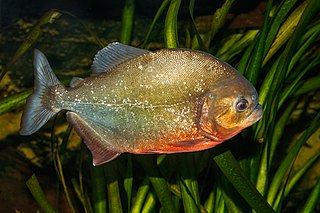
The red-bellied piranha, also known as the red piranha, is a type of piranha native to South America, found in the Amazon, Paraguay, Paraná and Essequibo basins, as well as coastal rivers of northeastern Brazil. This fish is locally abundant in its freshwater habitat. They are omnivorous foragers and feed on insects, worms, crustaceans, and fish. They are not a migratory species but do travel to seek out conditions conducive to breeding and spawning during periods of increased rainfall. Red-bellied piranhas often travel in shoals as a predatory defense but rarely exhibit group hunting behavior. Acoustic communication is common and is sometimes exhibited along with aggressive behaviors. They are a popular aquarium fish.
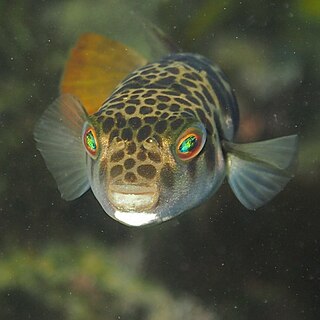
The smooth toadfish is a species of fish in the pufferfish family Tetraodontidae. It is native to shallow coastal and estuarine waters of southeastern Australia, where it is widespread and abundant. French naturalist Christophe-Paulin de La Poix de Fréminville described the species in 1813, though early records confused it with its close relative, the common toadfish. The two are the only members of the genus Tetractenos after going through several taxonomic changes since discovery.
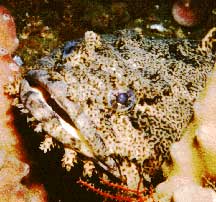
Toadfish is the common name for a variety of species from several different families of fish, usually because of their toad-like appearance. Dogfish is a name for certain species along the gulf coast.
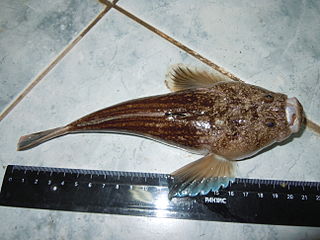
The Atlantic stargazer is a marine, subtropical fish of family Uranoscopidae. Its body is suited for living on the sea floor, and is one of few fish capable of bioelectrogenesis, or the ability to generate an electric charge.

Porichthys notatus is a species of batrachoid toadfish. It is a member of the midshipman genus, Porichthys, and is known by the common name plainfin midshipman. It is native to the eastern Pacific Ocean, where its distribution extends along the coast from Sitka, Alaska, to Magdalena Bay in southern Baja California.
Reproduction and vocalization in midshipman fish are closely interlinked. Mating in midshipman fish depends on auditory communication, the production and reception of sound signals. Males produce several different vocalizations, while females only make grunts in non-breeding situations.


